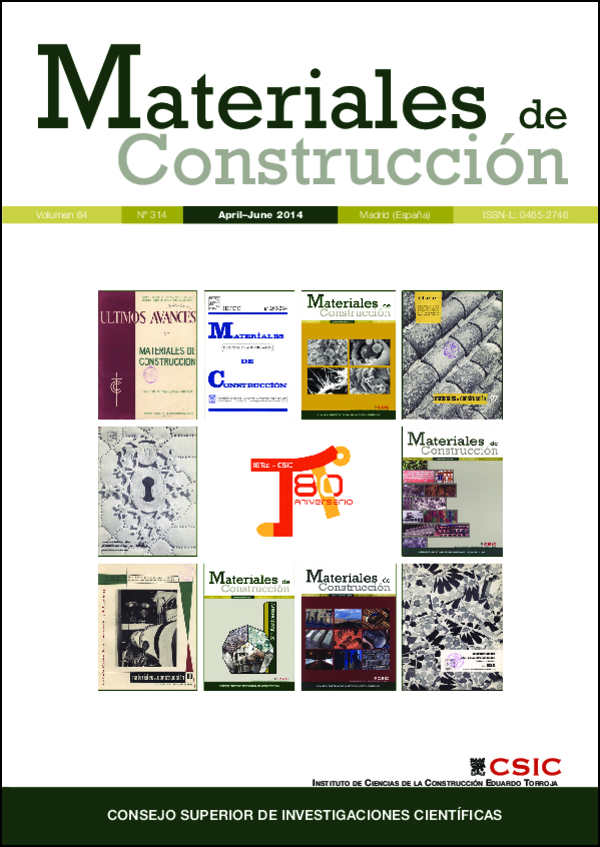Evaluation of the behavior of brick tile masonry and mortar due to capillary rise of moisture
DOI:
https://doi.org/10.3989/mc.2014.02513Keywords:
Brick, Brickwork, Rising damp, Absorption, ThermographyAbstract
For a better understanding of the behaviour of old brick masonry in facing the rising damp problem, multiple tests were made in the laboratory: water absorption, moisture content, apparent porosity, temperature and thermal camera imaging on brick masonry and its components: brick and mortar. This has allowed us to determine which of the previous tests is the best in predicting the behaviour of a real wall. In addition, the tests have also helped in defining a process to evaluate the moisture content of walls in a buildings, which is important for heritage restoration projects.
Downloads
References
Mason G. (1974) Rising damp, Build SCI 9, 227–231. http://dx.doi.org/10.1016/0007-3628(74)90021-8
Hall, C.; Hoff, W.D. (2007) Rising damp: capillary rise dynamics in walls, Proceedings of The Royal Society A-Mathematical Physical And Engineering Sciences 463, 1871–1884. http://dx.doi.org/10.1098/rspa.2007.1855
Rirsch, E.; Zhang, Z. (2010) Rising damp in masonry walls and the importance of mortar properties, Construc. Build. Mat. 24, 1815–1820. http://dx.doi.org/10.1016/j.conbuildmat.2010.04.024
Peixotode Freitas, V.; Torres, M.I.; Guimarães, A.S. (2008) Humidade Ascensional, 106, Faculdade de Engenharia da Universidade do Porto, Porto.
Torres, I.; Peixoto de Freitas, V. (2010) The influence of the thickness of the walls and their properties on the treatment of rising damp in historic buildings, Construc. Build. Mat 24, 1331–1339. http://dx.doi.org/10.1016/j.conbuildmat.2010.01.004
Peixoto, V. (2012) Tratamiento da humidade ascensional em edifícios antigos, 4° Congreso de patología y rehabilitación de edificios. PATORREB 2012, 40.
De Villanueva, J. (1827) Arte de Albañilería o instrucciones para los jóvenes que se dediquen a él, en que se trata de las herramientas necesarias al albañil, formación de andamios, y toda clase de fábricas que se puedan ofrecer, Madrid. Norma UNE EN 772-16 (2001) Método de ensayo para piezas de fábrica de albañilería. Parte 16: determinación de las dimensiones.
UNE EN 772-13 (2001) Método de ensayo de piezas para fábrica de albañilería. Parte 13: Determinación de la densidad absoluta seca y de la densidad aparente seca de piezas para fábrica de albañilería (excepto piedra natural).
UNE EN 772-3 (1999) Método de ensayo para piezas de fábrica de albañilería. Parte 3: Determinación del volumen neto y del porcentaje de huecos por pesada hidrostática de piezas de arcilla cocida para fábrica de albañilería.
Camino M.S.; León F.J.; Llorente A.; Olivar J.M. (2012) Propuesta de ensayo para evaluar las barreras químicas para evitar la subida del agua del terreno en fábrica, 4° Congreso de patología y rehabilitación de edificios. PATORREB 2012, 163.
Fort, R.; Álvarez de Buergo, M.; López de Azcona, M.; Mingarro, F.; Varas, M.; Soriano, J. (2004) Caracterización de la Fábrica de Ladrillo del Palacio del Infante Don Luis, Boadilla del Monte, Madrid, Boletín de la Sociedad Española de Cerámica y Vidrio, 43 [2], 578–582. http://dx.doi.org/10.3989/cyv.2004.v43.i2.599
Setti, M.; Lanfranchi, A.; Cultrone, G.; Marinoni, L. (2012) Archaeometric investigation and evaluation of the decay of ceramic materials from the church of Santa Maria del Carmine (Pavia, Italy), Mater. Construcc. 62, [305], 79–98. http://dx.doi.org/10.3989/mc.2011.62310
Published
How to Cite
Issue
Section
License
Copyright (c) 2014 Consejo Superior de Investigaciones Científicas (CSIC)

This work is licensed under a Creative Commons Attribution 4.0 International License.
© CSIC. Manuscripts published in both the print and online versions of this journal are the property of the Consejo Superior de Investigaciones Científicas, and quoting this source is a requirement for any partial or full reproduction.
All contents of this electronic edition, except where otherwise noted, are distributed under a Creative Commons Attribution 4.0 International (CC BY 4.0) licence. You may read here the basic information and the legal text of the licence. The indication of the CC BY 4.0 licence must be expressly stated in this way when necessary.
Self-archiving in repositories, personal webpages or similar, of any version other than the final version of the work produced by the publisher, is not allowed.
















